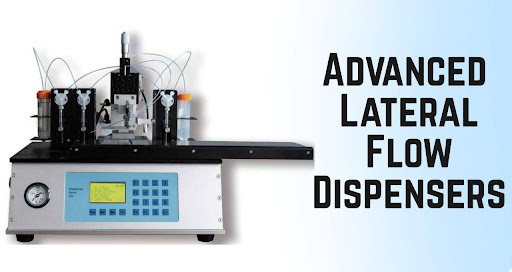In the fast-moving world of diagnostics, there is no room for error. Whether testing for infectious disease-causing pathogens, monitoring allergens in foods, or testing for environmental contaminants, test strip accuracy is of utmost importance to deliver true results. This is true with the lateral flow dispenser, one of these unassuming heroes when it comes to contributing accuracy. Using these efficiently designed instruments, equal application of reagents on test membranes is guaranteed, and in the process, it significantly affects the test’s performance.
Understanding the Backbone of Diagnostic Strip Manufacturing
Test strips can appear blandly unassuming, but they are products of sophisticated engineering and chemistry. A standard lateral flow assay (LFA) consists of a handful of components: sample pad, conjugate pad, membrane, and absorbent pad. But at the heart of the test—the membrane—is where the diagnostic magic happens. It is here that reagents are applied in targeted lines, which function as control and test zones.
This is where the lateral flow dispenser comes in. By uniformly coating antibodies, antigens, or detection particles onto the membrane, the dispenser ensures consistent performance per test strip. Staying off this course of action will result in false positives, asymmetric line intensity, or test failure. Consistency isn’t a choice—it’s crucial.
How a Lateral Flow Dispenser Works
A lateral flow dispenser is in fact a high accuracy fluid handling device. It is used to control the amount, position, and level of lines of reagent deposited on the test strip membrane. Most of the dispensers are compatible with biological reagents like colloidal gold, latex particles, fluorescent labels, or enzymes. Model-wise, dispensers can be contact or non-contact operated.
Contact dispensers use micro-nozzles or touching pins to physically touch the membrane to deliver fluid. They are cheaper and simpler to use.
Non-contact dispensers use solenoid valves, piezoelectric jets, or air pressure to release drops from close contact. These are more accurate and do not harm the membrane—particularly when working with sensitive biomaterials.
Why Precision Matters More Than Ever
There was a huge need for lateral flow tests during the COVID-19 pandemic across the globe, and even today, their use keeps expanding in healthcare, veterinary medicine, and food businesses. In such critical applications, mistakes in manufacturing strips can be disastrous.
Take as an example a test kit that is producing uneven results due to asymmetrical deposition of the reagent. This not only would break down public confidence, but it can also cause misdiagnosis or undue delay in treatment. Contemporary lateral flow dispensers steer clear of such a risk of occurring by providing ultra-consistent application—even thousands of strips per day.
Modern Lateral Flow Dispenser Features
Contemporary dispensers are engineered with performance, speed, and usability in focus. Some of the most critical features include:
- Microliter accuracy: Accurate dispensing of liquid enables high reproducibility.
- Programmable software interfaces: For line spacing, length, and rate of deposition determination.
- Multiple membrane compatibility: Nitrocellulose, glass fiber, etc., support.
- Multi-line operation: For concurrent application of test and control lines.
All of these advanced features together allow manufacturers to increase production capacity without lowering the quality control—a diagnostics necessity today.
The Role of Lateral Flow Dispensers in Quality Control
Quality control is not merely defect detection subsequent to manufacture; it starts from the design and assembly phase. A lateral flow dispenser adds value through reducing variability in manufacture. If every strip takes the same volume of reagent, the same concentration, and in exactly the same position, then there is reduced human error or wastage of material.
Furthermore, programmable parameters of advanced dispensers allow operators to pre-program batch-based procedures, reducing setup time and offering batch-to-batch consistency. This is especially of use while performing a switch between products for different diagnostic targets.
Applications across Industries
While usually denoting medical diagnostics, lateral flow dispensers have extensive applications:
- Healthcare: For infectious disease tests (e.g., COVID-19, malaria, HIV), hormonal diseases, or cardiac markers.
- Food safety: Allergen, Salmonella, or GMO detection in processed food.
- Veterinary medicine: Rapid testing for farm animal or pet disease.
- Environmental monitoring: Contaminant screening of water or ground samples.
All these applications need various reagents and degrees of accuracy but all may benefit from the accuracy and flexibility of high-grade dispensers.
Challenges in Reagent Dispensing and How Technology Solves Them
The most difficult aspect of reagent dispensing is the maintenance of reagent activity over the period of use. Shear-sensitive, heat-sensitive, and pH-sensitive biological substances like proteins are some of the other materials. Spontaneous denaturation by error can deactivate proteins by simply mishandling them.
Sophisticated lateral flow dispensers handle such materials with care. Non-contact dispensing systems as a whole are valued for minimizing mechanical stress during dispensing. Onboard temperature control systems, further, can keep reagents in stable conditions for high-volume runs.
The second challenge is consistent line morphology—i.e., the line must be consistent, have well-defined edges, and not contain gaps. The new dispensers utilize precise jetting and real-time feedback control to compensate for variations during flight so that every test strip will be within strict specifications.
Emerging Innovations and Trends
While demand for point-of-care diagnostics keeps on rising, the market for lateral flow technology is developing rapidly. An emerging trend is the utilization of AI and machine vision in dispenser systems. Using these technologies, line quality can be monitored in real-time and parameters can be set automatically—another reduction of human touch and room for error.
A second. Modular dispenser platforms. These allow for easy capacity increases or reagent profile modifications without tooling up a whole production line. This is more flexible manufacturing, more able to match the pace of increasingly dynamic diagnostic demands.
Finally, miniaturization of the dispensers is gaining popularity. Benchtop-sized units provide miniature size, rapid prototyping, and low-volume manufacturing—ideal for research labs or new test kit companies developing new test kits.
Things to Keep in Mind while Selecting a Lateral Flow Dispenser
When you are on the lookout for a dispenser, it is important that you keep your own needs in mind. Ask yourself the following questions:
- What range of volume am I going to need for my reagent?
- Do I need contact or non-contact dispensing?
- How many lines do I need to dispense per strip?
- Is software integration important to my production process?
A good quality lateral flow dispenser will accommodate your production volume, contain your reagent type, and provide the adaptability to switch later on. Investing money in quality dispensing equipment in the beginning tends to save waste, less time to production, and less recalls down the line.
A Glimpse into the Future of Diagnostics
As the world turns towards decentralized, patient-driven healthcare, diagnostic testing needs to be made more precise, convenient, and scalable. Behind every successful test strip lies a very sophisticated, very fine-tuned manufacturing process—and at its center lies the lateral flow dispenser.
Instead of a simple device, the dispenser is a quality control sentinel of a vitally important step with consequences for the performance, shelf life, and user confidence in the test. While the diagnostics market expands, so too will its role in making sure each and every test meets its promise through the use of such high-accuracy devices.





























